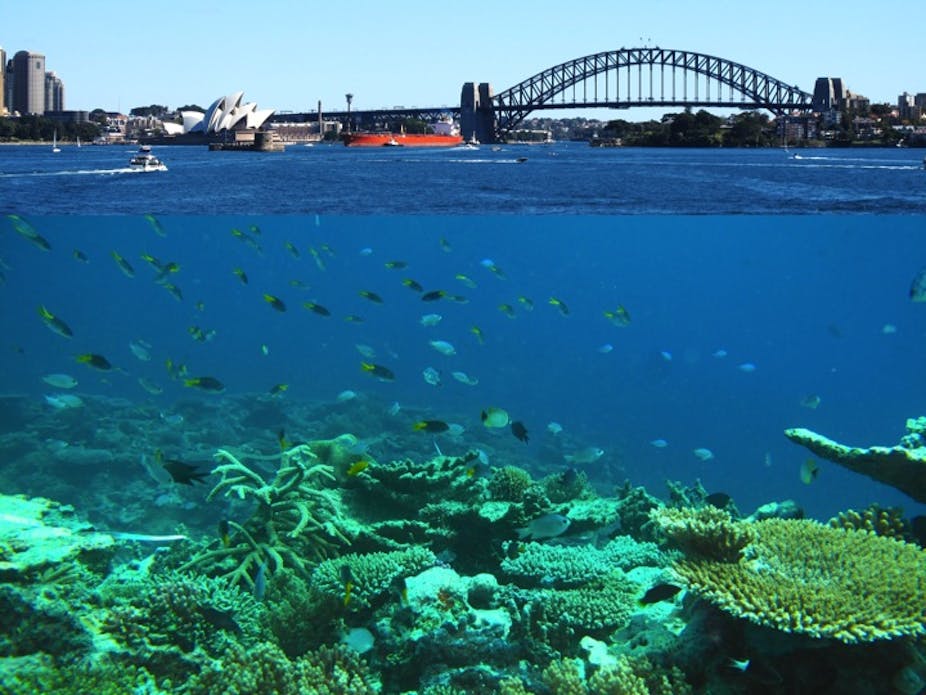Welcome to tropical Sydney, where colourful surgeonfishes and parrotfishes are plentiful, corals have replaced kelp forests, and underwater life seems brighter, more colourful and all-round better. Or is it?
While this vision of a future Sydney is just an embellished cartoon of what climate change would do off the city’s coastline, our recent research does point to a widespread “tropicalisation” of temperate coastlines such as Sydney within the next few decades. This may sound pleasant, but it can lead to unwanted consequences.
Turning tropical
Climate models suggest that ocean temperatures off Sydney are just decades away from becoming “tropical”. A “business as usual” scenario of increasing CO2 emissions suggests winter sea surface temperatures will consistently exceed 18 degrees C between 2020 and 2030. And summer sea surface temperatures will consistently exceed 25 degrees C between 2040 and 2060.

Eastern Australia waters represent a climate change hotspot, with warming rates occurring twice as fast as the global average. A key reason for this is a strengthening of the East Australian Current, which pushes warm tropical water southwards.
Other oceanic hotspots around the world include southern Japan, south east USA, south east Africa and eastern South America. All these regions have in common the influence of strong ocean currents running close to the shore bringing warm tropical water.
Heading south
So what will warmer ocean temperatures do to Sydney? Examining what’s happening within these other hotspots can help us to make some predictions.
In our study, recently published in Proceedings of the Royal Society B, we show how tropical fishes are becoming increasingly abundant in many warming hotspots. Indeed, tropical fishes are already a common feature in Sydney during the late summer months, and some have even started to survive over winter.
And fish are not the only organisms moving. Tropical corals have also started to make their way down the NSW coastline, and researchers are now on the look out for them in the waters off Sydney.

Ocean deforestation
Nobody would complain if the only consequence of climate change was more species of marine life — greater biodiversity. However with these gains also come substantial losses. And the biggest losers are underwater algal forests.
Canopy algae, or seaweeds, are the linchpin of temperate coastlines. They provide food and shelter to hundreds of species, and fulfil a role similar to trees in terrestrial forests. However algal forests need relatively cool water to survive, and this is becoming increasingly elusive in these regions.

A dramatic example of warmer water on algal forests occurred during the extreme ocean heat wave off Western Australia associated with the massive La Niña in early 2011. Extreme ocean warming lasted only a few weeks, caused an unprecedented decline of algal forests and the temperate marine life communities they support.
So why is warm water damaging to algal forests? There are a few reasons. High temperatures can directly stress algae by damaging the machinery that supports their survival. Warmer tropical water also carries fewer nutrients, which the algae need to grow.
Arrival of the algae eaters
And now our research is uncovering a new mechanism leading to the loss of algal forests: increased grazing by the very same tropical fishes that we were initially so happy to see along our coastlines.
The harmful effect of warm-water fish on temperate reefs is most evident in southern Japan and the eastern Mediterranean, where algal forests have dramatically declined.
In a paper published last week in the Journal of Ecology, we show how the invasion of tropical rabbitfish in the eastern Mediterranean has created eerie barren areas extending over hundreds of kilometres. These new habitats support less than half the species found in the nearest algal forests.

Similarly, off southern Japan over 40% of algal forests have disappeared since the 1990s; a phenomenon known as isoyake. Increased annual grazing rates by tropical rabbitfish and parrotfish appear to be the primary culprit. Now corals dominate at many sites.
Japanese people are famous for their love of algae — they have dedicated shrines and eat them with nearly every meal. Consequently there is considerable concern over their loss. It has also resulted in the complete collapse of abalone fisheries, and the cultivation of other commercially important species such as the Japanese amberjack is becoming increasingly difficult.

So what can we do to stop temperate algal forests turning tropical? To prevent further dramatic changes we ultimately need to reduce our CO2 emissions. In the meantime, we could also encourage new fisheries in temperate reefs that target tropical fishes. Rabbitfish, for example, are considered a delicacy in many Indo-pacific countries and already make up a sizeable component of fisheries catches in the eastern Mediterranean.

